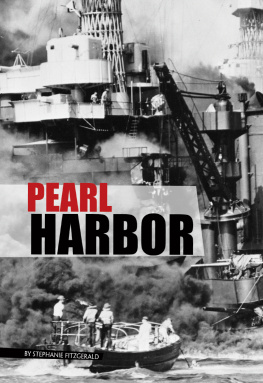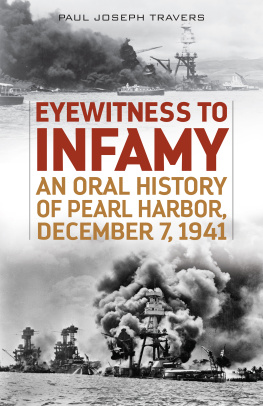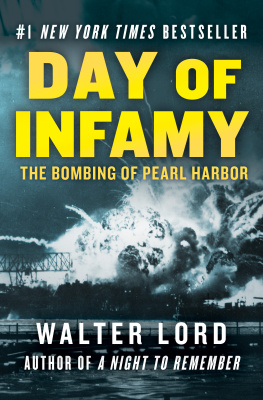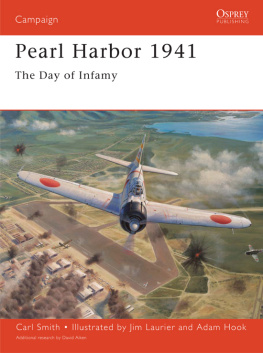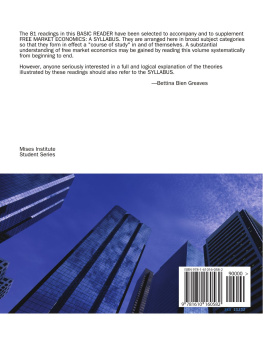Greaves Bettina B. - Pearl Harbor : the seeds and fruits of infamy
Here you can read online Greaves Bettina B. - Pearl Harbor : the seeds and fruits of infamy full text of the book (entire story) in english for free. Download pdf and epub, get meaning, cover and reviews about this ebook. City: Au, year: 2010, publisher: Ludwig von Mises Institute, genre: History. Description of the work, (preface) as well as reviews are available. Best literature library LitArk.com created for fans of good reading and offers a wide selection of genres:
Romance novel
Science fiction
Adventure
Detective
Science
History
Home and family
Prose
Art
Politics
Computer
Non-fiction
Religion
Business
Children
Humor
Choose a favorite category and find really read worthwhile books. Enjoy immersion in the world of imagination, feel the emotions of the characters or learn something new for yourself, make an fascinating discovery.
- Book:Pearl Harbor : the seeds and fruits of infamy
- Author:
- Publisher:Ludwig von Mises Institute
- Genre:
- Year:2010
- City:Au
- Rating:3 / 5
- Favourites:Add to favourites
- Your mark:
- 60
- 1
- 2
- 3
- 4
- 5
Pearl Harbor : the seeds and fruits of infamy: summary, description and annotation
We offer to read an annotation, description, summary or preface (depends on what the author of the book "Pearl Harbor : the seeds and fruits of infamy" wrote himself). If you haven't found the necessary information about the book — write in the comments, we will try to find it.
Pearl Harbor : the seeds and fruits of infamy — read online for free the complete book (whole text) full work
Below is the text of the book, divided by pages. System saving the place of the last page read, allows you to conveniently read the book "Pearl Harbor : the seeds and fruits of infamy" online for free, without having to search again every time where you left off. Put a bookmark, and you can go to the page where you finished reading at any time.
Font size:
Interval:
Bookmark:
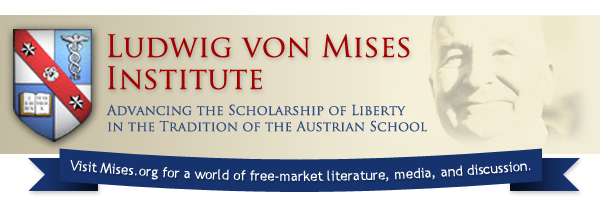
Pearl Harbor
The Seeds and Fruits of Infamy
Percy L. Greaves, Jr.
Bettina B. Greaves, ed.
Foreword by John Chamberlain
LvMI
MISES INSTITUTE
ISBN: 978-1-933550-33-6
Copyright 2010 by the Ludwig von Mises Institute and published under the Creative Commons Attribution License 3.0. http://creativecommons.org/licenses/by/3.0.
For information write the Ludwig von Mises Institute, 518 West Magnolia Avenue, Auburn, Alabama 36832. Mises.org.
No one can plan history. Every one of usrich and poor, powerful and not so powerful, famous and infamous, important and unimportantplans his or her actions in the hope of accomplishing some goal. History is the outcome of countless such purposive actions, intertwined, interconnected, interrelated. Although each action is planned by the individual actor in the hope of achieving some end, history itself is not only not planned, but unplannable. And so it is with the Pearl Harbor disaster which launched the United States into World War II. It was the unplanned, unintended consequence of countless separate pre-attack planned actions on the part of the principals concerned. And the post-attack coverup and revelations arose as the unintended consequences of the purposive actions of the principals concerned.
The goal of the historian of any historical event is to try to discover how it happened as an unintended consequence of the purposive actions of individuals. And that is the goal of this book, as it was also the goal of the post-attack investigations, to determine how and why the Japanese attacked Pearl Harbor and how and why Washington officials responded as they did. My husband, Percy Greaves, became interested in the pros and cons of the December 7, 1941 attack from the moment he learned, as research director of the Republican National Committee during the 1944 Roosevelt-Dewey presidential election campaign, that the United States had decrypted the Japanese diplomatic code in August 1940 and since then had been reading many of Japans SECRET and SUPER-SECRET messages. That secret, of course, could not be divulged so long as the war continued and we were continuing to decipher Japanese messages and learn their secrets.
After the war ended in August 1945, Congress established a Joint Congressional Committee to investigate the attack. As Chief of the Minority Staff of that Joint Committee my husband researched the pre-attack background, the earlier investigations, and the available documents. He helped brief the Republican Committee members in questioning witnesses as to what was known in Washington about Japans plans before the attack, what intelligence and materiel had been furnished the Pearl Harbor commanders, and whether or not they had responded appropriately, given the available intelligence, materiel, ships, planes, and men. The hearings lasted almost a full year. The Majority Report continued to place considerable blame on the Hawaiian commanders, Admiral Husband E. Kimmel and General Walter C. Short. A lengthy Minority Report held that the blame must be shared by higher-up Washington officials.
Upon the conclusion of the Congressional Committee hearings, my husband continued to research the Pearl Harbor attack. He interviewed surviving participants, wrote and lectured widely on the subject. My husband completed this manuscript and wrote the side heads. We proofed it together and checked all the quotations and footnotes against the original sources. But then he was stricken with cancer, a particularly virulent variety. He died on August 13, 1984, just over a month after the appearance of his first serious symptoms.
By the time my husband died, his efforts had yielded a massive manuscript. When I reread that manuscript after his death, I decided that, although the names, dates, and documentation were all there, it was difficult to follow the sequence of events. Events alternated with revelations gleaned from the investigations and revelations alternated with events. Also Percy had included many lengthy supporting quotations within the text itself, interrupting the flow of events. In the hope of making the story easier to understand, I have arranged everything in chronological order and paraphrased the quotesfrom FDRs inauguration and his early active intervention in international affairs through the Japanese attack on December 7, 1941, the post attack investigations, the obstacles placed in the path of investigators, down to the final reports.
He and I often talked about this book. As usual I made suggestions; some he accepted; others he rejected. He would say, If anything happens to me then you can do as you please. Of course, he fully expected to finish it himself. But time was not given him to do so.
Although I have reworked my husbands manuscript, it remains his book. The research and documentation are his. The decision to present events primarily as they were viewed from Washington was his. My contribution has been to reorganize, revise, and rewrite his manuscript so as to present the events chronologically. Throughout, however, I have tried to keep the book true to his research and faithful to his interpretation. My guiding principle has always been to present the results of Percys years of research as faithfully and accurately as possible and to describe the truth about Pearl Harbor as he saw it.
Although I am sure Percy would have had some criticism of the way I have finished his book, on the whole I believe he would have approved. I only wish he could have lived to see the research of his lifetime published in this form. Any errors or omissions in preparing his work for final publication are, of course, my responsibility alone.
Mrs. Percy L. (Bettina B.) Greaves, Jr.
May 2007
When the attack on Pearl Harbor was announced on the radio, my sister phoned. I was outdoors playing touch football with my nine-year-old boy and some of his friends. I went inside immediately and turned on the radio. From that moment on I have followed Pearl Harbor developments closely.
At dawn on December 7, 1941, the Japanese had attacked the United States U.S. Fleet stationed in Pearl Harbor in the Hawaiian Islands. Hawaii was then a territory of the United States, not yet a state. Nevertheless, that blow brought the United States into the war that had been started in Europe by Hitlers attack on Poland in September 1939. The war then exploded worldwide, with fronts not only in Europe and in the Atlantic but also in Asia and the Pacific.
The generally accepted explanation for our entry into the war was simply Japans unprovoked and dastardly attack on Pearl Harbor. However, the responsibility for the extent of the disaster was attributed to a considerable extent to failures on the part of the two commanders at Pearl HarborNavy Admiral Husband E. Kimmel and Army General Walter C. Short. To many, this settled the matter; the two commanders were to blame, held up to public shame, relieved of their commands, and forced into early retirement.
The first hint I had that there was more to the Pearl Harbor story came in 1944. The then Republican candidate for President, Thomas E. Dewey, was trying to unseat President Franklin D. Roosevelt. Several service personnel came to the Republican National Committeeof which I was then Research Director with reports that U.S. cryptographers had deciphered some of the Japanese codes and that Washington officials had been reading, even before the attack, many of the Japanese governments confidential communications.
Font size:
Interval:
Bookmark:
Similar books «Pearl Harbor : the seeds and fruits of infamy»
Look at similar books to Pearl Harbor : the seeds and fruits of infamy. We have selected literature similar in name and meaning in the hope of providing readers with more options to find new, interesting, not yet read works.
Discussion, reviews of the book Pearl Harbor : the seeds and fruits of infamy and just readers' own opinions. Leave your comments, write what you think about the work, its meaning or the main characters. Specify what exactly you liked and what you didn't like, and why you think so.



